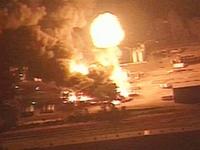-
Using bacteria to create self-healing concrete
Cement production has an impact on the environment as it is very energy intensive, accounting for about 7 percent of the total anthropogenic atmospheric CO2 emissions; in addition to the energy consumption from production and transportation, air pollution, as well as land use and impacts on the landscape from related mining activities are also matters of concern; means of increasing the service life of concrete structures would make the material not only more durable, but also more sustainable — and researchers find that embedding certain bacteria in the concrete promises to do just that
-
-
Asteroids: Earth will be hit by a shotgun blast instead of a single cannonball
Scientists find that many asteroids are not solid rocks, but a collection of small gravel-sized rocks, held together by gravity; instead of a solid mountain colliding with Earth’s surface, the planet would be pelted with the innumerable pebbles and rocks of which it is composed, like a shotgun blast instead of a single cannonball; this knowledge could guide the defensive tactics to be taken if an asteroid were on track to collide with the Earth
-
-
Water-proofing cities by using buildings for flood protection
Buildings, car parks, and roads can be designed in such a way that they can protect the urban area behind them from flooding, alongside their regular urban functions; these innovative construction techniques can also be adapted to the circumstances in the long term, enabling flood protection systems to take account of external influences such as climate change and economic development
-
-
New method predicts communication-disrupting solar activity
Major solar eruptions (coronal mass ejections) normally take several days to reach the Earth, but the largest recorded in 1859 took just eighteen hours; solar flares — which can also cause significant disruption to communications systems — take just a few minutes; U.K. researchers develop a method of predicting solar storms that could help to avoid widespread power and communications blackouts
-
-
Scientist offers better ways to engineer Earth's climate to blunt global warming
A Canadian scientist suggests two novel geoengineering approaches to limit the effects of climate change on Earth: “levitating:” engineered nano-particles, and the airborne release of sulphuric acid; both ideas are more refined than, and have advantages over, another geoengineering concept developed by geoengineers: mimicking volcanic eruptions by injecting massive amounts of sulphur dioxide gas into the upper atmosphere
-
-
Small thorium reactors could lead to fossil-fuel-free world within five years
An argument is made that nuclear reactors which use thorium as an accelerator (hence the technical name: Accelerator Driven Thorium Reactors, or ADTR) could lead to fossil-fuel-free world within five years; thorium is an abundant mineral deposit, with 3 to 5 times more thorium in the world than uranium; more importantly, virtually all of the thorium mined can be used as fuel compared to only 0.7 percent of the uranium recovered in its natural state, this means, in energy terms, that one ton of thorium mined is equivalent to 200 tons of uranium mined, which is equivalent to 3.5 million tons of mined coal; ADTRs also enjoy proliferation resistance advantages compared to other reactor systems
-
-
Dramatic climate change is unpredictable
Scientists examine two models to explain climate change; one scenario is like a seesaw that has tipped to one side; if sufficient weight is placed on the other side the seesaw will tip — the climate will change from one state to another (an ice age, or warmer climate as is the case today); in the other model, the climate is like a ball in a trench, which represents one climate state; the ball is continuously pushed by chaos-dynamical fluctuations, and the turmoil in the climate system may finally push the ball over into the other trench, which represents a different climate state
-
-
Are New Orleans' storm defenses strong enough?

The U.S. Army Corps of Engineers has invested $14.45 billion in bolstering New Orleans’ defenses against storms, and there is a consensus that the city’s protection now is better than they were on 29 August 2005, when Katrina made landfall, and its 8.5-meter surge went on to overpower a poorly constructed and poorly connected levees and flood walls; critics say, though, that the better designed and built levees do not take into account the stronger hurricanes which climate changes causes, and that the best defenses against hurricanes — coastal marshes, wetlands, and barrier islands — are being eroded and lost at an alarming rate as a result of urban development and the Corps’ own engineering approach to harnessing and taming the Mississippi River
-
-
U.S. military wants to cyber-protect critical infrastructure
The U.S. military wants to exert more influence over the protection of power grids, transportation networks, and financial network systems because the military relies on these networks to deal with suppliers and these networks could become military targets
-
-
Texas police building withstands gun attack, showing value of secure design
Secure access points and the arrangement of rooms create a buffer between McKinney law enforcement officials and the public; windows sit just above eye level to prevent direct attack; they slope to limit ledges for explosive devices; bulletproof glass protects the lobby, and bullet-resistant liner lies inside the masonry walls
-
-
Small bridge sensors will give early warnings of anomalies, weaknesses
University of Maryland researchers devised a lightweight, low-power, wireless, credit card-sized sensor that will detect weaknesses in bridges and other infrastructure before they can turn into calamities; the sensors would detect anomalies in the structure of even the most inaccessible parts of bridges and send alerts via cellular frequencies to its human masters. Among the things it would measure would be stress loads, vibration, temperature and the creation and growth of cracks
-
-
New levee design, construction materials tested in Louisiana
Since Katrina, attention has been riveted on $14 billion worth of federal projects to rebuild the deficient hurricane levee system so it can better defend from surges out of lakes Borgne and Pontchartrain; the Army Corps of Engineers plans to start experimenting with a new construction method, which relies on a mix of lime and clay to build the test levee higher without widening the levee base; this method of raising existing river levees can be done faster than a standard raising and will not require buying additional land to expand the base; mixing lime and clay and water will not produce concrete, which has a measured strength of 3,000 pounds per square inch, or psi, the mixture will have a strength of 80 to 120 psi — substantially greater than the 3 to 5 psi of a compacted clay levee
-
-
Disaster response experts call for "red-helmet brigade"
Experts say that the world need to be better prepared to respond to natural disasters such as the Pakistan floods of the Haiti earthquake; they say that an organization such as the UN Office for the Coordination of Humanitarian Affairs should establish a special response unit to set up a computerized database that identifies all available assets routinely needed in an emergency — emergency personnel, medical personnel, water, non-perishable food stuffs, extraction machinery, temporary shelters, and field hospitals; some supplies could be held in locations around the world, ready to be dispatched as soon as disaster assessment experts working for a central command and control center arrive on the scene of a catastrophe
-
-
China, Pakistan floods; Haiti earthquake: not merely "natural" disasters
The recent disasters in Pakistan, China, and Haiti have done more than kill thousands and displace millions: they have raised questions about whether the modifier “natural” — as in “natural disaster” — is accurate in describing the sources and scope of the catastrophes; these and other recent disasters, in other words, raise questions about how much of the damage caused comes from the forces of nature and how much is the result of human activity; experts say that a major contributing factor to the scope of these disasters are development decisions which are too often controlled by wealthy and corrupt elites who have no interest in protecting people who have been marginalized by poverty
-
-
Chemical industry spends millions shaping chemical facilities security legislation

Fourteen parent companies own chemical plants which endanger a large number of people in the United States in the event of an accident or attack on one of their chemical facilities; these 14 parent companies own 163 facilities in 37 different states and Puerto Rico; the facilities owned by The Clorox Company, Kuehne Chemical, and JCI Jones Chemical each put more than 12 million people at risk; these fourteen companies and their affiliated trade associations spent $69,286,198 lobbying the committees with jurisdiction over chemical security legislation in 2008 and 2009; the political action committees (PACs) of these fourteen companies and the PACs of their affiliated trade associations gave $2,187,868 in the 2008 election cycle and the 2010 cycle to date directly to the campaigns of members of the committees of jurisdiction over chemical security legislation
-
- All
- Regional
- Water
- Biometrics
- Borders/Immig
- Business
- Cybersecurity
- Detection
- Disasters
- Government
- Infrastructure
- International
- Public health
- Public Safety
- Communication interoperabillity
- Emergency services
- Emergency medical services
- Fire
- First response
- IEDs
- Law Enforcement
- Law Enforcement Technology
- Military technology
- Nonlethal weapons
- Nuclear weapons
- Personal protection equipment
- Police
- Notification /alert systems
- Situational awareness
- Weapons systems
- Sci-Tech
- Sector Reports
- Surveillance
- Transportation
Advertising & Marketing: advertise@newswirepubs.com
Editorial: editor@newswirepubs.com
General: info@newswirepubs.com
2010-2011 © News Wire Publications, LLC News Wire Publications, LLC
220 Old Country Road | Suite 200 | Mineola | New York | 11501
Permissions and Policies
Editorial: editor@newswirepubs.com
General: info@newswirepubs.com
2010-2011 © News Wire Publications, LLC News Wire Publications, LLC
220 Old Country Road | Suite 200 | Mineola | New York | 11501
Permissions and Policies
